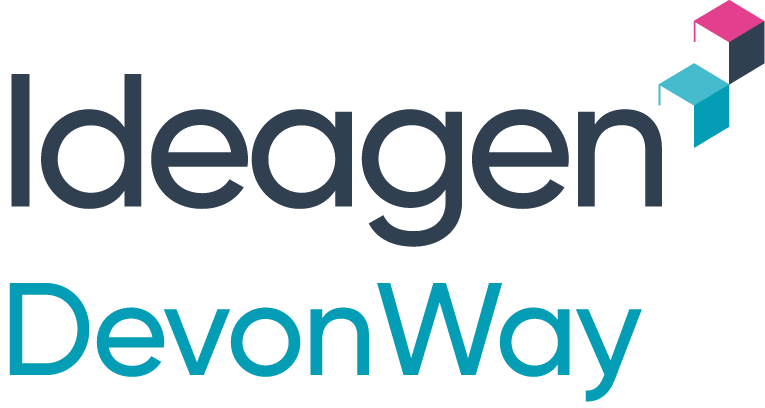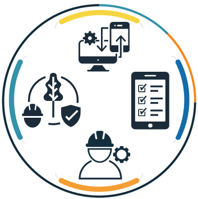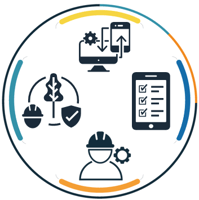The Ultimate Guide to ESG Terminology
From DevonWay

ESG Terminology Explained
Feel like you're increasingly seeing terms like ESG, GHG, and CSR? You are! We're here to help with DevonWay's Ultimate Guide to ESG Terminology. Can't find an ESG-related term on our list? Let us know. If we add it, we'll send you a thank-you gift.
Environmental, Social, and Governance (ESG) has quickly become a boardroom and C-level issue. Companies are publicizing aggressive goals for reducing greenhouse gas (GHG) emissions to net zero and beyond, and they're reporting on their efforts to improve ESG ratings. Use this guide to decipher the jargon and join the conversation.
Jump to terms alphabetically:
A
Absolute zero target is a goal of no greenhouse gas emissions with no offsets: No new GHG emissions are to be created by the transition away from fossil fuels.
C
Cap and trade is a carbon trading model that sets a cap, or maximum, on the total amount of certain greenhouse gases that can be emitted collectively among a group of companies. Within that cap, companies can buy or receive emissions allowances, which they can trade with each other. The EU Emissions Trading System (EU ETS) is the world's first and largest carbon market.
Carbon dioxide is a colorless, odorless gas produced by burning carbon and organic compounds and by respiration. It is naturally present in air (about 0.03 percent) and is absorbed by plants in photosynthesis. In the context of ESG, carbon dioxide is a Greenhouse Gas (see below).
Carbon emissions are carbon dioxide produced by ("emitted" by) planes, cars, factories, and other things into the atmosphere. The amount of carbon emissions and other greenhouse gases trapped in our atmosphere causes global warming.
Carbon footprint is the amount of carbon dioxide and other carbon compounds emitted due to the consumption of fossil fuels by a particular person, group, or other entity.
Carbon markets are trading systems for buying and selling units of greenhouse-gas emissions.
Carbon negative is the same as climate positive (see below).
Carbon neutral means that a company's carbon dioxide emissions are balanced by an equivalent amount removed (either physically or through purchase of offsets).
Carbon offset is an action intended to compensate for the emission of carbon dioxide into the atmosphere as a result of industrial or other human activity, especially when quantified and traded as part of a commercial program. In other words, instead of reducing your carbon footprint, you purchase offsets from companies or organizations that are reducing carbon emissions.
Carbon Trade, also known as carbon emissions trading, "is the buying and selling of credits that permit a company or other entity to emit a certain amount of carbon dioxide or other greenhouse gases. The carbon credits and the carbon trade are authorized by governments with the goal of gradually reducing overall carbon emissions and mitigating their contribution to climate change." (See Investopedia)
CDP is a not-for-profit charity that runs the global disclosure system for investors, companies, cities, states and regions to manage their environmental impacts.
Circular economy refers to an economy that uses a systems-focused approach and involves industrial processes and economic activities that are restorative or regenerative by design, enable resources used in such processes and activities to maintain their highest value for as long as possible, and aim for the elimination of waste through the superior design of materials, products, and systems including business models. The EPA (US Environmental Protection Agency) has some good info.
Clean energy is carbon-free energy from renewable sources that have little to no greenhouse gas emissions, such as solar, wind, water, geothermal, bioenergy, and nuclear power.
Climate positive means that an activity removes carbon dioxide from the atmosphere, thus having a positive effect on climate change.
Compliance Management Software improves compliance, performance, and visibility into an organization's compliance to regulations, standards, and contracts. Thus it's often a critical part of ESG and Sustainability software.
COP21, also known as the Paris Agreement, is the 2015 United Nations Climate Change Conference held in Paris, France December 2015. COP stands for Conference of Parties.
COP26, also known as Glasgow COP26, is the 2021 United Nations Climate Change Conference held in Glasgow, Scotland, October 31 to November 13, 2021. COP stands for Conference of Parties.
CSR is short for Corporate and Social Responsibility, a term used to describe a company's environmental- and social-focused programs and initiatives. Related terms are Corporate Citizenship and Social and Environmental Responsibility (SER).
D
DEI stands for Diversity, Equity, and Inclusion.
DevonWay ESG & Sustainability software (SaaS) helps companies in regulated, high-risk industries to measure and improve ESG performance and achieve goals. It provides a management framework for improving any ESG metric on a unified platform that can also run your safety, quality, asset, and work management operations. It can also serve as the system of record for datasets that feed into ESG metrics and ratings. Leading ESG frameworks like GRI and SASB are built in.
E
EHS stands for Environmental Health & Safety. EHS software, like DevonWay EHS, automates safety processes and regulatory compliance.
ESG stands for Environmental, Social, and Governance. ESG represents how a company performs relative to each of these areas:
- Environmental is how the company behaves as a steward of nature reducing impact on climate change, pollution, and other environmental impact.
- Social represents how the company manages relationships with its employees, suppliers/vendors, customers, and communities. This area may include diversity, equity, and inclusion (DEI) and social justice.
-
Governance refers to how the company manages itself, its leadership, executive pay, audits, internal controls, compliance with regulations and standards, etc.
ESG Ratings - We like this definition from the Motley Fool website: "An ESG rating measures a company's exposure to long-term environmental, social, and governance risks. These risks -- involving issues such as energy efficiency, worker safety, and board independence -- have financial implications. But they are often not highlighted during traditional financial reviews. Investors who use ESG ratings to supplement financial analysis can gain a broader view of a company's long-term potential."
EPA stands for the US Environmental Protection Agency, created in 1970 to “protect human health and the environment” through developing and enforcing regulations, giving grants, studying environmental issues, partnering with organizations, teaching people about the environment, and publishing information.
EU Emissions Trading System (EU ETS) is the world's first and largest carbon market, "a cornerstone of the EU's policy to combat climate change and its key tool for reducing greenhouse gas emissions cost-effectively." It works on the "cap and trade" model: A cap, or maximum, is set on the total amount of certain greenhouse gases that can be emitted collectively. Within that cap, companies can buy or receive emissions allowances, which they can trade with each other. The cap is reduced over time so that total emissions fall.
G
Glasgow COP2 is the2021 United Nations Climate Change Conference held in Glasgow, Scotland, October 31 to November 13, 2021. COP stands for Conference of Parties.
Global Reporting Index (GRI) Standards are a set of global standards for corporate sustainability reporting.
Global warming is a gradual increase in the overall temperature of the earth's atmosphere generally attributed to the greenhouse effect caused by increased levels of carbon dioxide, chlorofluorocarbons, and other pollutants.
Greenhouse effect is the trapping of the sun's warmth in a planet's lower atmosphere due to the greater transparency of the atmosphere to visible radiation from the sun than to infrared radiation emitted from the planet's surface. If that's confusing, check out https://climatekids.nasa.gov/greenhouse-effect/
GHG stands for Greenhouse Gas, a gas that contributes to the greenhouse effect by absorbing infrared radiation. The primary greenhouse gases in the earth's atmosphere are water vapor, carbon dioxide, methane, nitrous oxide, and ozone.
GHG Emissions stands for Greenhouse Gas Emissions.
GHG Emissions Standards - There are different and evolving standards for reporting GHG emissions. The most common standard globally is the GHG Protocol.
Green Building, according to the US Green Building Council, "is a holistic concept that starts with the understanding that the built environment can have profound effects, both positive and negative, on the natural environment, as well as the people who inhabit buildings every day. Green building is an effort to amplify the positive and mitigate the negative of these effects throughout the entire life cycle of a building."
Greenhouse Gas, or GHG, is a gas that contributes to the greenhouse effect by absorbing infrared radiation. The primary greenhouse gases in the earth's atmosphere are water vapor, carbon dioxide, methane, nitrous oxide, and ozone.
GHG Protocol or GHGP is an internationally recognized standard for measuring and reporting GHG emissions. This standard defines three Scopes:
- Scope 1, direct emissions: Emissions created from company-owned assets or controlled resources, for example, the combustion of fossil fuel to run a vehicle, boiler or perhaps backup diesel generators used to protect a data center owned by the organization.
- Scope 2, indirect emissions: Emissions from the generation of energy that is purchased by the organization, for example, the procurement of electricity or steam to be used in an office, warehouse, manufacturing facility or data center.
- Scope 3 upstream and downstream emissions: Accounts for all indirect emissions (not included in Scope 2) that occur in the value chain (both upstream and downstream from the organization)
GRI is the Global Reporting Index (see above).
M
Materiality in the context of ESG means the key material issues supporting an organization's ESG strategy.
Materiality assessment in the context of ESG is an exercise of identifying and prioritizing key material issues supporting an organization's
MSCI ESG Rating is a rating reflecting a company's resilience to ESG risks. MSCI is a leading provider of critical decision support tools and services for the global investment community. According to their website, they "use a rules-based methodology to identify industry leaders and laggards according to their exposure to ESG risks and how well they manage those risks relative to peers. Our ESG Ratings range from leader (AAA, AA), average (A, BBB, BB) to laggard (B, CCC)."
L
LEED stands for Leadership in Energy and Environmental Design. It's a building rating system that provides a framework for healthy, efficient and cost-saving green buildings.
Life Cycle Assessment (LCA) measures the environmental impacts of a product or service.
N
Net-Zero carbon emissions means that an activity releases no new carbon emissions into the atmosphere or is offset by carbon removal.
Net-Zero emissions means that an activity balances all greenhouse gas (GHG) released and removed from the atmosphere.
Net-Zero Standard from the Science Based Targets Initiative "provides the guidance and tools companies need to set science-based net-zero targets."
O
Offset in the context of ESG usually means carbon offset: an action intended to compensate for the emission of carbon dioxide into the atmosphere as a result of industrial or other human activity, especially when quantified and traded as part of a commercial program. In other words, instead of reducing your carbon footprint, you purchase offsets from companies or organizations that are reducing carbon emissions.
Ozone is a colorless unstable toxic gas with a pungent odor and powerful oxidizing properties, formed from oxygen by electrical discharges or ultraviolet light. It differs from normal oxygen (O2) in having three atoms in its molecule (O3).
Ozone layer is a layer in the earth's stratosphere at an altitude of about 6.2 miles (10 km) containing a high concentration of ozone, which absorbs most of the ultraviolet radiation reaching the earth from the sun.
P
The Paris Agreement is a legally binding international treaty on climate change. It was adopted by 196 Parties at COP 21 in Paris, on 12 December 2015 and entered into force on 4 November 2016. Often called the Paris Accords or the Paris Climate Accords, it covers climate change mitigation, adaptation, and finance. Its goal is to limit global warming to below 2, preferably to 1.5 degrees Celsius, compared to pre-industrial levels.
PRI stands for the United Nations Principles for Responsible Investment. See United Nations Principles for Responsible Investment below.
Purpose-driven company or organization develops programs that have environmental and/or social impact in addition to their business purpose.
R
Recycling, according to the EPA “is the process of collecting and processing materials that would otherwise be thrown away as trash and turning them into new products. Recycling can benefit your community and the environment.”
S
SASB stands for the Sustainability Accounting Standards Board, a non-profit organization that develops sustainability accounting standards. See below for more info.
The Science Based Targets Initiative is a collaboration between CDP, the United Nations Global Compact, World Resources Institute and the World Wide Fund for Nature. Since 2015 more than 1,000 companies joined the initiative to set a science-based climate target. (See Wikipedia)
Scope 1, 2, or 3 - See GHG Protocol above.
SDGs is an acronym for the United Nations Sustainable Development Goals, described below.
SER stands for Social and Environmental Responsibility.
SICS® stands for Sustainable Industry Classification System® (see below).
Social Impact Statement is a written explanation by an organization of how its activities impact the communities within which it operates.
Social Justice refers to "justice in terms of the distribution of wealth, opportunities, and privileges within a society." (See Wikipedia)
Socially responsible investing, social investment, sustainable socially conscious, "green" or ethical investing, is any investment strategy which seeks to consider both financial return and social/environmental good to bring about social change regarded as positive by proponents. (See Wikipedia)
Supply Chain Sustainability is the collective, total impact of a company’s supply chain on the environment, human rights, fair labor practices, and anti-corruption policies.
Sustainability is the ability to be maintained at a certain rate or level. In the context of climate change, sustainability is the avoidance of the depletion of natural resources in order to maintain an ecological balance.
Sustainability Accounting Standards Board (SASB) is a non-profit organization that develops sustainability accounting standards.
Sustainable Development Goals - See United Nations Sustainable Development Goals below.
Sustainable Industry Classification System® (SICS®) is an industry classification system developed by SASB to group companies into sectors and industries that groups like companies based on their sustainability-related risks and opportunities.
T
TCFD stands for Task Force on Climate-related Financial Disclosures, a group created by the Financial Stability Board to improve and increase reporting of climate-related financial information.
U
United Nations Principles for Responsible Investment (PRI) is a United Nations independent entity that encourages investors to use responsible investment to enhance returns and better manage risks. Its six Principles for Responsible Investment "offer a menu of possible actions for incorporating ESG issues into investment practice. The Principles were developed by investors, for investors. In implementing them, signatories contribute to developing a more sustainable global financial system. They have attracted a global signatory base representing a majority of the world’s professionally managed investments." (See https://www.unpri.org/about-us/about-the-pri)
UNEP stands for the United Nations Environment Programme.
UNFCCC stands for the United Nations Framework Convention on Climate Change.
United Nations Sustainable Development Goals, also called SDGs or Global Goals, are a collection of 17 interlinked global goals designed to be a "blueprint to achieve a better and more sustainable future for all". The SDGs were set up in 2015 by the United Nations General Assembly and are intended to be achieved by the year 2030. (See Wikipedia)





